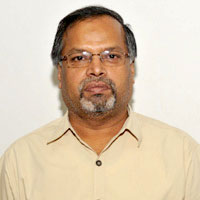डॉ. सुरेंद्र कुमार एम.बी.बी.एस.
वैज्ञानिक डी
आईसीएमआर-राष्ट्रीय जनजाति स्वास्थ्य अनुसंधान संस्थान
प्रोफ़ाइल
डॉ. सुरेंद्र कुमार एक चिकित्सा वैज्ञानिक हैं और वर्तमान में उनका अनुसंधान क्षेत्र आदिवासी आबादी में तंबाकू से संबंधित रोग पर केंद्रित है, विशेष रूप से मौखिक ल्यूकोप्लाकिया में जो तंबाकू उपयोगकर्ता में सामान्य है। भविष्य में, उनकी योजना इस आदत को एनआरटी थेरेपी के माध्यम से कम करने की है।
शोध के विषय
- Tobacco related disease
- Health and Nutrition
- Hemoglobinopathy
- Filaria
- Tuberculosis
वैज्ञानिक कर्मचारी
- V. Soan, Principal Technical Officer
- Maya Pandey, Tech. Officer
विगत शोध छात्र
N/A
जारी अनुसंधान परियोजनाएं
- A three step approach ABC (Ask, Brief advice, Cessation support) to help tribal population to quit tobacco use and to make their home tobacco free.
वर्तमान अनुसंधान सहयोगी
- Government Of Madhya Pradesh
विगत अनुसंधान सहयोगी
- Indian Council of Medical Research
समाचार में शोध
N/A
पुरस्कार / मान्यता / सम्मान
N/A
संगठित कार्यशाला / सम्मेलन
N/A
शैक्षणिक योगदान
- Supervisor of Ph. D. thesis: N/Á
- Masters dissertation: N/A
- Papers published:
अनुसंधान अनुदान
N/A
प्रकाशन
- Kumar S, Kumar D, Soan V, Pandey M, Mishra DK, Muniyandi M (2013) Poverty Does Not Limit Tobacco Consumption among Tribal Populations: Evidence from Central India. Asian Pacific Journal of Cancer Prevention: 14 (10), 6195- 6196. https://pdfs.semanticscholar.org/cede/9027e9aa86197a0d8885e3702aa630197f68.pdf
- Yadav R, Singh MPSS, Kumar S, Doll CK, Bhardwas VK, Gupta RB, Rajasubramaniam S (2013) Morbidity profile of sickle Cell Disease in tribal of Madhya Pradesh. Tribal Health Bulletin, Vol.17 No (1&2) 2011, pp 37-41.http://www.nirth.res.in/publications/tribal_health_bulletin/2011.pdf
- Kumar S, Muniyandi M (2015) Tobacco Use and Oral Leukoplakia: Cross-sectional Study among the Gond Tribe in Madhya Pradesh Asian Pacific Journal of Cancer Prevention, 16 (4), 1515-1518. https://www.ncbi.nlm.nih.gov/pubmed/25743823
- Yadav R, Lazarus M, Ghanghoria P, Singh MPSS, Gupta RB, Kumar S, Sharma RK, Rajasubramaniam S (2016) Sickle cell disease in Madhya Pradesh, Central India: A comparison of clinical profile of sickle cell homozygote vs. sickle-beta thalassaemia individuals Hematology; 1-6.DOI: 10.1080/10245332.https://www.ncbi.nlm.nih.gov/pubmed/27077770
- Kumar S, Muniyandi M, Dinesh Kumar D, Pandey M, Soan V, Rajasubramaniam S (2016) Chronic Obstructive Pulmonary Disease: Understanding and promoting healthy lifestyle among Gond Tribe in Madhya Pradesh International Journal of Current Microbiology and applied Sciences; 5 (10); 27-32.https://www.researchgate.net/publication/309022055_Chronic_Obstructive_Pulmonary_Disease_Understanding_and_Promoting_Healthy_Lifestyle_among_Gond_Tribe_in_Madhya_Pradesh_India
- Singh MPSS, Gupta RB, Yadav R, Kumar S, Godbole S, Rajasubramaniam S (2014) Haemoglobin Disorders among Scheduled Caste and Scheduled Tribe Populations of Two Adjoining Districts of Madhya Pradesh -Tribal Health Bulletin: 21(1), 32-36. http://www.nirth.res.in/publications/tribal_health_bulletin/thb21_1_2014.pdf
- Rao VG, Yadav, R, Dolla CK, Kumar S (2005) Under nutrition and childhood mortality among tribal preschool children of M.P. Indian Journal of Medical Research: 122, 43-47. http://icmr.nic.in/ijmr/2005/july/0704.pdf
- Das D, Kumar S, Sahoo PK, Dash AP (2005) A survey of bancroftian filariasis for microfilariae and circulating antigenaemia in two villages of Madhya Pradesh. Indian Indian Journal of Medical Research: 121: 771-775.https://www.ncbi.nlm.nih.gov/pubmed/16037622
- Das D, Kumar S, Dash AP, Babu BV (2005) Knowledge of lymphatic filariasis among the population of an endemic area in rural Madhya Pradesh, India. Annals of Tropical Medicine and Parasitology: 99: 101-104.https://www.ncbi.nlm.nih.gov/pubmed/15701261
- Das D, Kumar S (2007) Filarial hydrocele management in global programme on elimination of Lymphatic filariasis. Current science: 93 (9&10): 1200. https://www.researchgate.net/publication/290542116_Filarial_hydrocele_management_in_global_programme_on_elimination_of_lymphatic_filariasis_3


